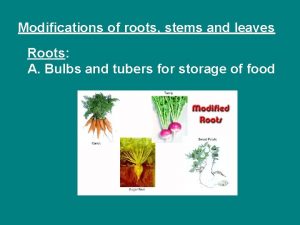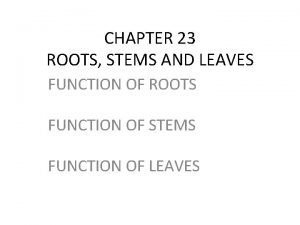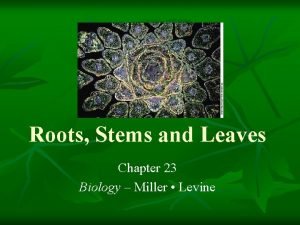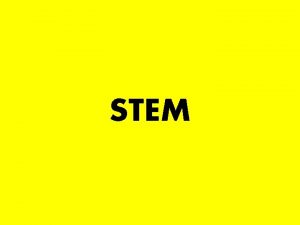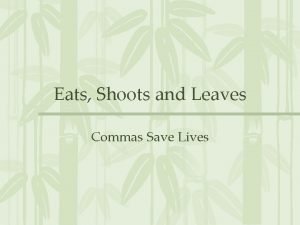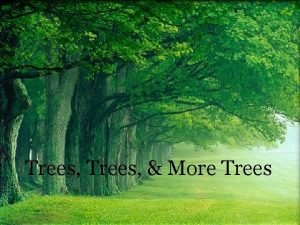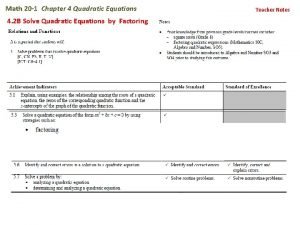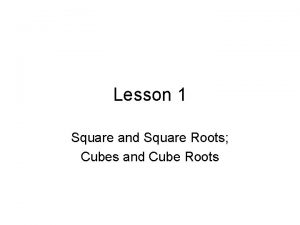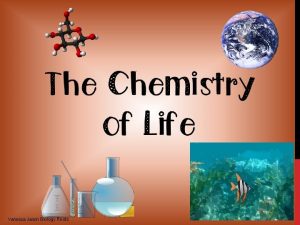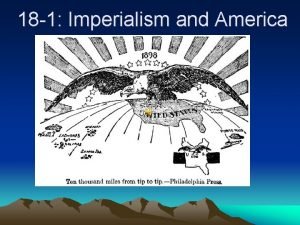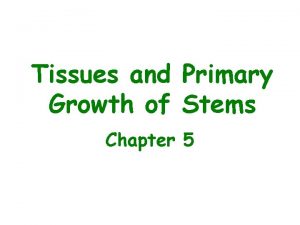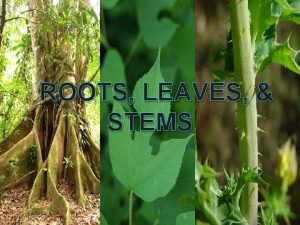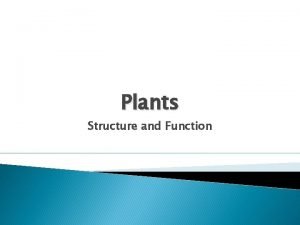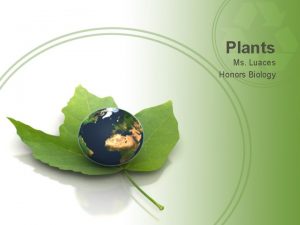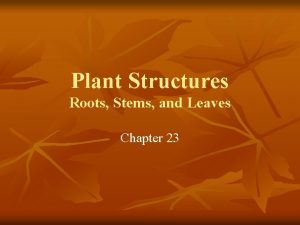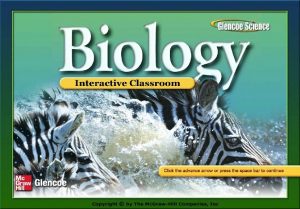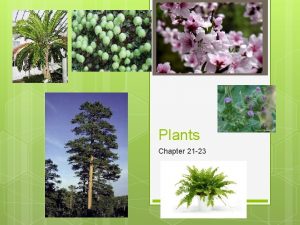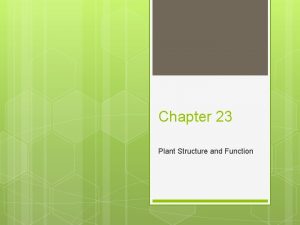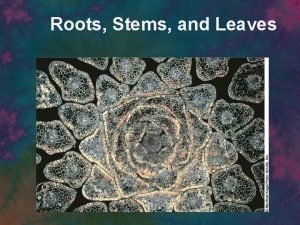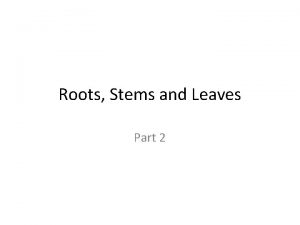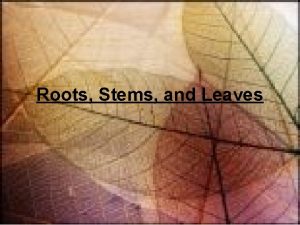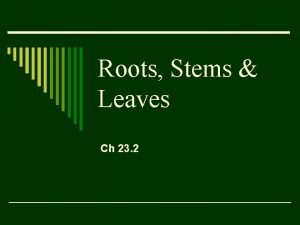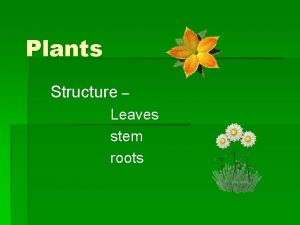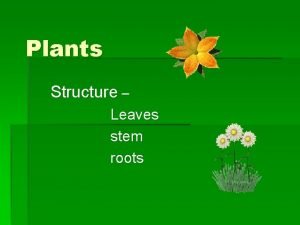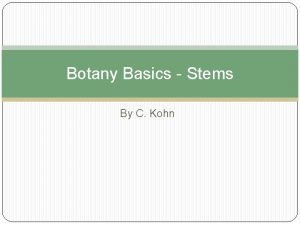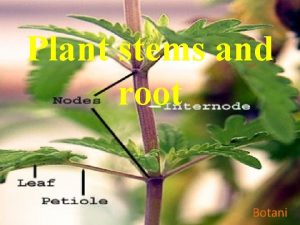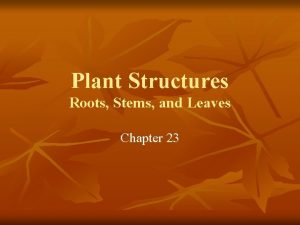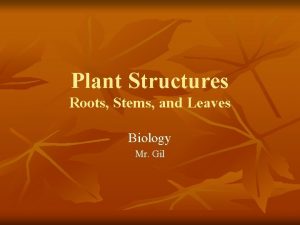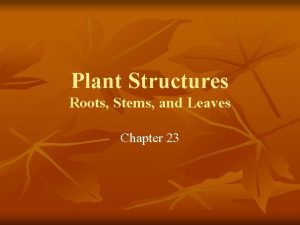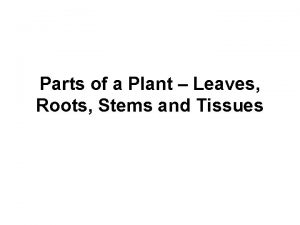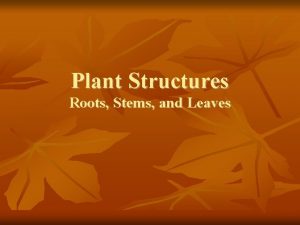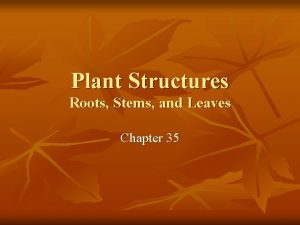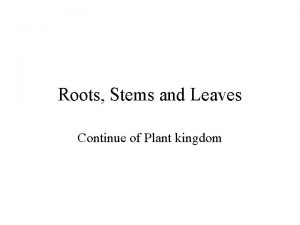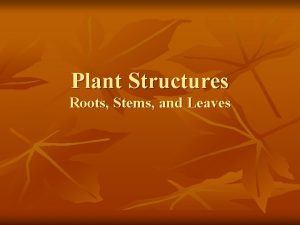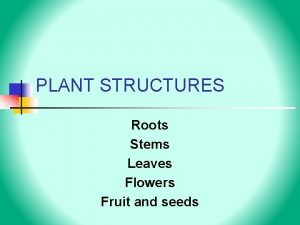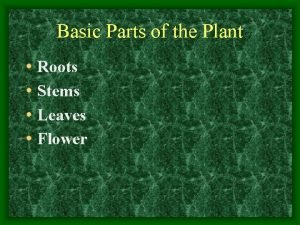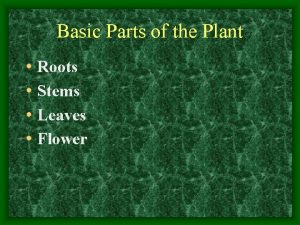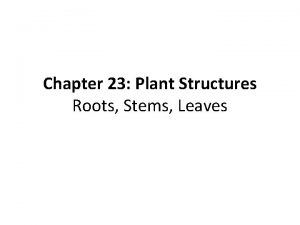Plant Structure and Function Roots Stems and Leaves

























- Slides: 25

Plant Structure and Function Roots, Stems, and Leaves

What is a Plant? • Plants are living things that have roots, stems, and leaves ~ some have flowers • Plants are made of cells that have cell walls, a large central vacuole, and chloroplasts • Chloroplasts contain a green pigment called chlorophyll that play a role in photosynthesis

Photosynthesis 6 H 2 O + 6 CO 2 -----> C 6 H 12 O 6+ 6 O 2

Life on Land – Adaptations! Problem • Drying Out • Making Food • Reproduction • Gravity & Support • Getting water & nutrients Solution • Waxy cuticle, stomata • Formed leaves • Develops spores & seeds • Bark (cork) & vessels; cell walls (cellulose) • Roots & vessels

Protections and Support - Leaf

Classification • VASCULAR: have tube-like structures that carry water, nutrients, and other substances through the plant • NONVASCULAR: do not have these tube-like structures and use other ways to move water and substances • Binomial Nomenclature: two word system of naming things, e. g. , Quercus alba = white oak

Seedless Nonvascular Plants • Don’t grow from seeds; just a few cells thick and only 2 to 5 cm in height; no flowers or cones ~ reproduce by spores – Mosses -Liverworts -Hornworts

Nonvascular Plants and the Environment • Pioneer species: first organisms to grow in new or disturbed areas – As pioneer plant species grow and die, decaying material builds up; this, along with the slow breakdown of rocks, builds soil ~ as a result, other organisms can move into the area!

Seedless Vascular Plants • Reproduce by spores • Have long, tube-like cells that carry water, minerals, and food to cells throughout the plant – Can grow bigger and thicker because of this – 1, 000 species of fern, ground pine, and spike mosses; 12, 000 species of ferns! FERN GROUND PINE SPIKE MOSS HORSETAIL

Ferns • Largest group of seedless vascular plants • Fern leaves are called fronds • Ferns produce spores in structures on underside of fronds • Ferns that lived 360 million years ago grew as tall as 25 m, but today, tallest tree ferns are about 3 m to 5 m in height

Club Mosses • Ground pines and spike mosses • Have needle-like leaves • Spores produced at end of stem in structures that look like tiny pine cones • Endangered in some areas, as they have been collected to make wreaths

Horsetails • Stem is jointed and has a hollow center surrounded by a ring of vascular tissue; at each joint leaves grow out from around the stem • Spores are produced in a cone-like structure at the tips of some stems • Stems contain silica, a gritty substance found in sand – “scouring rush”

Importance of Seedless Plants • When ancient seedless plants died, they became submerged in water and mud before they decomposed – over time, plant material became coal! • Today, decaying plants are compressed into a substance called peat, which forms from the remains of sphagnum moss – used as lowcost fuel in places such as Ireland Russia

Uses of Seedless Vascular Plants • Peat and sphagnum mosses used for gardening • Peat used as soil conditioner • Ferns used for weaving material and basketry • Rhizomes and young fronds of ferns are edible • Dried stems of one type of horsetail can be ground into flour • Folk medicines to treat bee stings, burns, fevers, and even dandruff!

Seed Plants • Have leaves, roots, stems, and vascular tissue; produce seeds • Gymnosperms and Angiosperms • Leaf made up of different layers of cells – – Waxy cuticle Epidermis (Stomata surrounded by guard cells) Palisade layer – most food produced here Spongy layer – veins containing vascular tissue found here – Lower Epidermis

Leaf Structure

Stems and Roots • Herbaceous stems: soft and green • Woody stems: hard, rigid • Roots have vascular tissue in which water and dissolved substances move from the soil through the stems to the leaves; roots also act as anchors • Roots can store food, e. g. , carrots, beets • Absorb oxygen for use in respiration ~ making energy for the plant’s cells

Vascular Tissue • Xylem: hollow, tubular cells stacked one on top of the other to form a structure called a vessel; transport water and dissolved substances • Phloem: tubular cells that are stacked to form structures called tubes; move food from where it is made to other parts of the plant where it is used or stored • Cambium: between xylem and phloem; produces new xylem and phloem

Gymnosperms • Oldest trees alive • Produce seeds not protected by fruit; “naked seeds”; do not have flowers • Leaves needle-like or scale-like • Four divisions: – Coniferophyta: conifers-pines, firs, spruces, redwoods, junipers – Cycads – Gingkoes – Gnetophytes

Angiosperms • Vascular plant that flowers and has a fruit that contains one or more seeds • Division: Anthophyta – Monocots – one cotyledon used for food storage, e. g. , corn, rice, wheat, barley, lilies, orchids, grass – Dicots – two cotyledons; shade trees, fruit trees; petunias; geraniums; snapdragons

Monocots • Flower parts in multiples of three • Leaves are more narrow than long • Vascular bundles show up as parallel veins in leaves • Vascular tissues are arranged as bundles scattered throughout the stem • Seeds have just one cotyledon

Dicots • Flower parts in multiples of four or five • Vascular bundles are the network of veins in the leaves • Vascular bundles occur in rings (annual rings in woody stems) • Seeds have two cotyledons

Life Cycles of Angiosperms • Biennials: complete their life cycles within two years • Annuals: complete their life cycles in one year • Perennials: take more than two years to grow to maturity

Some Products from Gymnosperms • Lumber, paper, soap, varnish, paints, waxes, perfumes, edible pine nuts, medicines

Some Products from Angiosperms • Foods, sugar, chocolate, cotton cloth, linen, rubber, vegetable oils, perfumes, medicines, cinnamon, flavorings (toothpaste, chewing gum, candy, etc. ), dyes, lumber • FLOWER PARTS • SMARTBOARD REVIEW
 Root stem and leaf are modified in
Root stem and leaf are modified in Leaf structure cube
Leaf structure cube Leaf function
Leaf function Leaf cell types
Leaf cell types Flexible stems
Flexible stems Jaringan
Jaringan Lesson 3 existence and uniqueness
Lesson 3 existence and uniqueness Eats shoots and leaves joke
Eats shoots and leaves joke Which part of the plant carries and protects the seed
Which part of the plant carries and protects the seed Leaves branches trunk and roots song
Leaves branches trunk and roots song Perfect squares notes
Perfect squares notes X 1 2 formula
X 1 2 formula Perfect cubes list
Perfect cubes list Vanessa jason biology roots answer key
Vanessa jason biology roots answer key The roots of american imperialism 1. economic roots
The roots of american imperialism 1. economic roots Xylem in stem
Xylem in stem What is the function of a stem in a plant
What is the function of a stem in a plant What is the function of stems?
What is the function of stems? Function of stems
Function of stems What is the function of stems?
What is the function of stems? Venus fly trap structural adaptation
Venus fly trap structural adaptation Plant and animal cell diagram
Plant and animal cell diagram Chapter 22 plant structure and function answer key
Chapter 22 plant structure and function answer key Chapter 21 plant structure and function
Chapter 21 plant structure and function Section 23-4 leaves
Section 23-4 leaves Phyllid
Phyllid
